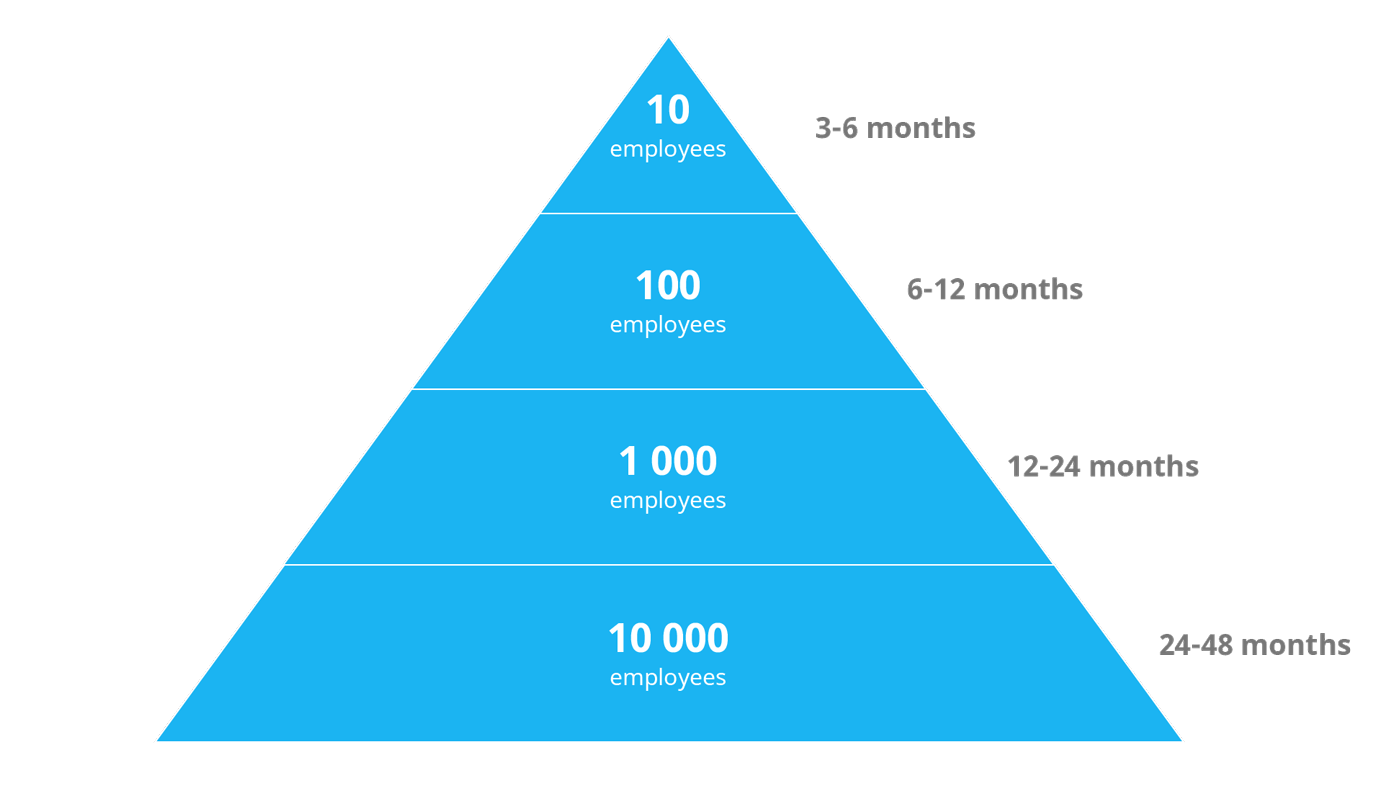Transforming Corporate Culture with Innovation Practices
The most innovative companies are usually lauded for their great culture, and for a reason.
Culture determines how things get done in an organization, especially when the boss isn’t around to tell people what to do.
Thus, a company with a healthy culture of innovation has people on all levels of the organization looking to find ways to solve problems or tackle new opportunities by questioning the way things are currently being done.
Culture is thus a very scalable way to drive innovation across the entire organization.
Yet, most organizations don't have a very pro-innovation culture. We’ve talked to hundreds of organizations about innovation and quite a few of them see culture as an overwhelming barrier for driving innovation.
However, it doesn't have to be that way.
As we’ve previously explained, with the right practices, you don’t need to just wait for your culture to change.
You can, and should, start driving more innovation and transforming your culture at the same time. In this article, we’ll explore how to achieve that.
We recently explored the topic in more detail in a webinar of ours, so you might also want to take a look at the recording below or download the slides from here.
Table of contents
Cultural Change is an Iterative Process
To begin with, it’s important to understand that changing corporate culture doesn’t just happen overnight. Culture is such an all-encompassing concept that is affected by so many separate things that it always takes quite a bit of time and effort to change.
What’s more, as culture is a result of the people in your organization and people are always resistant to change, you can rest assured that cultural change will also face resistance.
With that nature, it shouldn’t come as a surprise that there really aren’t any silver bullets for changing culture.
Just setting up an innovation lab or hiring a number of innovative graduates for internships around the company can help in the process, but they won’t lead to change at large without a systematic plan in place.
Cultural change will always be a gradual and iterative process.
Just how long does it take?
Culture is in a constant state of flux, gradually moving one way, or another, as it's affected by anything and everything that's going in the organization.
So, just how long does it take for culture to change?
Well, it’s been shown that people usually adopt a new habit in anywhere from 18 to 254 days with an average of around two months.
So, should a small team apply the right methods for driving change, they can reasonably except significant changes to their culture in a matter of few months.
However, for a large organization, behavioral change happens in waves.

The change always starts with a certain group of people, which should usually be the top management.
Before the change can proceed to the next part of the organization, the behaviour of the initial group must first change for there to be any chance for a sustained movement, regardless of whether the change starts top-down or bottom-up.
Thus, the more people you have, the longer it is going to take for the transformation to happen.
As a rule of thumb, you can think that each additional layer in your organization roughly doubles the time as the laggards will only follow suit after their peers have already done so.

This model is primarily based on our experiences, so while it should give you a fairly accurate basis for setting your expectations, don’t consider it too literally.
The Six Steps to Transforming Corporate Culture
As explained, cultural change isn’t so much a clean process that moves from one step to the next. It’s more like climbing a mountain.
You set your sights on the peak, then plan the route there, but you also have to be prepared to deviate from the route if it turns out that the way is blocked. Sometimes you have to turn back and take a step back to ultimately get where you want to go.
However, as long as you persist and keep moving forward, you’ll eventually reach your destination.
Since getting started is often the hardest part, we’ve created a rough blueprint that you can use to start making your culture more innovative.

1. Why Innovate
The first thing you need to do is to clarify why you want to become more innovative. And just stating that “we must be more innovative in order to remain competitive” doesn’t cut it, you need to be more specific.
Create your best hypothesis about the future by trying to answer the following questions:
- How will the world change?
- How will the market develop?
- What will our customers desire tomorrow, next quarter, after two years, or in a decade?
- What new customer segments should we target to further grow?
- How will technology develop?
- Which trends are going to affect our business?
The answers to these questions will help you think about where you need to be in the future, which in turn determines how you should approach innovation.
Most of us aren’t in a position where we could try to address these questions for the entire organization, but that shouldn’t stop us from doing the same exercise for your own team.
To succeed in cultural change, the first step really is to be able to clearly communicate the rationale for the change.
2. Which Practices
Once people see the need for the change, the next step is to start to put it in practice.
It is, after all, only through concrete actions and enough repetitions that we form new habits, which in turn shape the culture.
So, when it comes to innovation, you need to figure out which practices and processes are best suited for your business.
We’ve written about different innovation processes, models and frameworks quite extensively in the past, so for more details on those topics, please refer to those articles.
While it’s hard to generalize the applicability of those practices, there are a number of factors affecting the applicability of each practice, which can help you choose the right one:
- Need for speed
- Customer centricity
- Intensity of R&D work
- Regulation
So, if you’re in a very fast-paced industry with little regulation and low technological barriers, your innovation practices should look quite different from those of a pharmaceutical company looking to develop a cure for cancer.
The key here is to obviously learn from your own past experiences, but to also benchmark others doing similar things to what you’d like to accomplish.
For example, if you’re looking to become better at developing online services, what are high performers in that business usually doing? How is that different from where you are now?
Once you have a suitable framework in place for hopefully making innovation happen, the next step is to stop removing obstacles for it.
3. Management structure
Innovation, by definition, is about creating and introducing something new.
Most organizations, however, aren’t built for creating new business, but for preserving and optimizing the existing one.

The management, governance and organizational structures can all play a role in hindering innovation.
Large organizations, however, also have significant enablers for innovation, namely existing resources, talent, customers and networks.
The majority of work in enabling innovation and changing culture actually lies in finding ways to use those assets to enable and support innovation, while at the same time removing the barriers preventing it.
Without the right management structures in place, you might be able to come up with hundreds or thousands of great ideas but will likely never be able to implement them, which means that the results will also be zero.
4. Path of least resistance
To succeed in creating a more innovative culture, you need to build an innovation movement within the organization.
In the beginning, it will be tough, but when you find the right supporters within the organization, your movement will gradually start to pick more steam and eventually you’ll reach the tipping point where the rest of the people have virtually no choice but to join in or risk being left on the outside.
This short video by Derek Sivers captures the idea brilliantly.
The key lies in finding those “crazy” first followers for your movement.
To succeed in that, you need to identify who the currently active innovators and the most respected and influential people within the organization are and win them over.
Role models have been shown time after time to be extremely influential in driving change.
5. Concrete results
When you have the right people on your side, you’re well on your way to make change happen.
However, to keep your movement from being shut down from the above (be it the management group, the board, or even your investors), you need to show concrete results.
If you focus exclusively on high risk, breakthrough innovation but can’t show any progress after a year or two, it’s highly likely that the organization will decide to cut those projects.
And even if they don’t, the excitement and traction that you’ve been able to build with your movement will gradually fade away without positive reinforcement.

So, start by creating measurable real-life results quickly and communicate about these wins openly.
This has the added benefit of helping you build and refine the innovation capabilities of your organization, which improves your chances of succeeding in those longer-term innovation projects.
6. Adapt and iterate
Regardless of how well you plan your cultural change, the one thing that is guaranteed is that the process will include a fair amount of trial and error and force you to look at your organization in a very holistic way.
However, as long as you treat innovation as a priority, communicate its importance and make concrete actions for supporting it, you’ll be well on your way to a more innovative culture. Even if it is just one step at a time, the end result is well worth the journey!
Again, for more of our thoughts on the topic, I’d recommend you watch the webinar and get a copy of the slides used.





